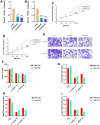High expression of serine protease 2 (PRSS2) associated with invasion, metastasis, and proliferation in gastric cancer
- PMID: 37022096
- PMCID: PMC10120911
- DOI: 10.18632/aging.204604
High expression of serine protease 2 (PRSS2) associated with invasion, metastasis, and proliferation in gastric cancer
Abstract
Background: Accumulating evidence indicates that the occurrence and development of tumors are related to the activation of oncogenes and the inactivation of tumor suppressor genes caused by epigenetic mechanisms. However, the function of serine protease 2 (PRSS2) in gastric cancer (GC) is still unknown. Our study aimed to find a regulation network involved in GC.
Methods: The mRNA data (GSE158662 and GSE194261) of GC and normal tissues were downloaded from the Gene Expression Omnibus (GEO) dataset. Differential expression analysis was performed using R software, and Gene Ontology (GO) analysis and Kyoto Encyclopedia of Genes and Genomes (KEGG) pathway analysis was conducted by using Xiantao software. Besides, we used Quantitative Real-time PCR (qPCR) to verify our conclusions. After gene knockdown, cell migration and CCK-8 experiment were carried out to detect the effect of gene on cell proliferation and invasion.
Results: Totally, 412 differentially expressed genes (DEGs) were identified from GSE158662 and 94 DEGs were identified from GSE196261. Km-plot database results indicated that PRSS2 exhibited high diagnosis worth for GC. Gene functional annotation enrichment analysis revealed that these hub mRNAs were mainly taken part in the process of tumorigenesis and development. Besides, vitro experiments showed that down-regulation of PRSS2 gene reduced the proliferation and invasion ability of GC cells.
Conclusions: Our results indicated that PRSS2 may play vital roles in the carcinogenesis and progression of GC and can be potential biomarkers for patients with GC.
Keywords: CCK-8; GEO; PRSS2; gastric cancer; qPCR.
Conflict of interest statement
Figures






References
Publication types
MeSH terms
Substances
LinkOut - more resources
Full Text Sources
Medical
Molecular Biology Databases
Miscellaneous

